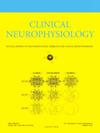Towards early diagnosis of amyotrophic lateral sclerosis using near fibre EMG
IF 3.7
3区 医学
Q1 CLINICAL NEUROLOGY
引用次数: 0
Abstract
Objective
Amyotrophic lateral sclerosis (ALS) is characterized by progressive loss of motor neurons and diagnosis is usually delayed several months. The continuous denervation and reinnervation associated with ALS are manifest in EMG signals as changes in motor unit potential (MUP) size, temporal dispersion and instability. Near Fibre EMG is a novel method to assess early changes in MUP temporal dispersion and instability using routinely recorded EMG signals in a semi-automated manner.
Methods
Near Fibre EMG values from 2318 MUs, retrospectively sampled at the time of ALS diagnosis, from 96 muscles of 15 patients were compared with values from 3954 MUs sampled from 109 muscles of 84 reference subjects.
Results
30.1% and 46.1% of ALS MUs had MUPs with increased complexity or instability, respectively, and 17.4% had both. The potential importance and heightened sensitivity of NFEMG was highlighted when analyzing normal-sized motor units; as many as 24% of the normal-sized MUPs actually had significant instability, while 14% had increased complexity, and 7.4% had both.
Conclusions
Near Fibre EMG can characterize motor unit electrophysiological status and hence help quantify the degree, and course of denervation and reinnervation.
Significance
Near-Fiber EMG offers the potential to facilitate earlier ALS diagnosis, which, as promising therapies become available, can be consequential.
肌萎缩性侧索硬化症近纤维肌电图的早期诊断
目的肌萎缩性侧索硬化症(ALS)以运动神经元的进行性丧失为特征,诊断通常延迟数月。肌萎缩侧索硬化症相关的连续去神经支配和再神经支配表现为运动单位电位(MUP)大小、时间弥散和不稳定性的变化。近纤维肌电图是一种新方法,利用常规记录的肌电图信号,以半自动化的方式评估MUP时间弥散和不稳定性的早期变化。方法将15例ALS患者的96块肌肉的2318块肌纤维肌电图与84例对照者的109块肌肉的3954块肌纤维肌电图进行比较。结果分别有30.1%和46.1%的ALS患者的肌纤维肌电图复杂性或不稳定性增加,17.4%的患者两者都有。在分析正常大小的运动单元时,强调了NFEMG的潜在重要性和高灵敏度;多达24%的正常大小的mup实际上具有明显的不稳定性,而14%的mup增加了复杂性,7.4%的mup两者兼有。结论近纤维肌电图可以表征运动单元的电生理状态,从而有助于量化神经去支配和神经再支配的程度和过程。近纤维肌电图提供了促进早期ALS诊断的潜力,随着有希望的治疗方法的出现,这可能是重要的。
本文章由计算机程序翻译,如有差异,请以英文原文为准。
求助全文
约1分钟内获得全文
求助全文
来源期刊

Clinical Neurophysiology
医学-临床神经学
CiteScore
8.70
自引率
6.40%
发文量
932
审稿时长
59 days
期刊介绍:
As of January 1999, The journal Electroencephalography and Clinical Neurophysiology, and its two sections Electromyography and Motor Control and Evoked Potentials have amalgamated to become this journal - Clinical Neurophysiology.
Clinical Neurophysiology is the official journal of the International Federation of Clinical Neurophysiology, the Brazilian Society of Clinical Neurophysiology, the Czech Society of Clinical Neurophysiology, the Italian Clinical Neurophysiology Society and the International Society of Intraoperative Neurophysiology.The journal is dedicated to fostering research and disseminating information on all aspects of both normal and abnormal functioning of the nervous system. The key aim of the publication is to disseminate scholarly reports on the pathophysiology underlying diseases of the central and peripheral nervous system of human patients. Clinical trials that use neurophysiological measures to document change are encouraged, as are manuscripts reporting data on integrated neuroimaging of central nervous function including, but not limited to, functional MRI, MEG, EEG, PET and other neuroimaging modalities.
 求助内容:
求助内容: 应助结果提醒方式:
应助结果提醒方式:


